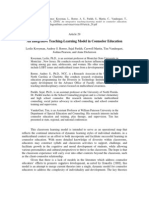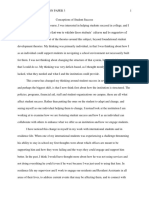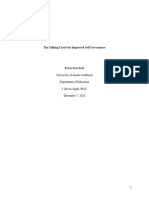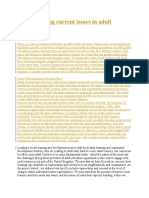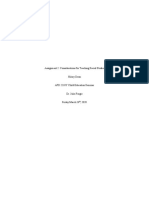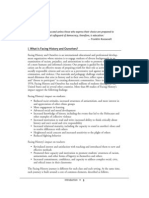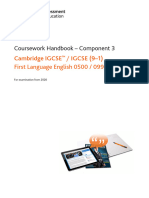0 ratings0% found this document useful (0 votes)
49 viewsRaspeakingup 1
Raspeakingup 1
Uploaded by
nenymurniatiStudent voice refers to actively involving students in shared decision making processes in schools. Research shows that student voice can help students develop skills, feel more confident speaking up about issues like bullying, and feel more positive about school. When students are listened to and involved in meaningful participation, they are more likely to develop a stronger sense of belonging, self-worth, identity as learners, and ability to create impact. Effective student voice requires schools to consider how to model social values, promote democratic decision making, handle conflicts, and teach students skills for supportive environments.
Copyright:
© All Rights Reserved
Available Formats
Download as PDF, TXT or read online from Scribd
Raspeakingup 1
Raspeakingup 1
Uploaded by
nenymurniati0 ratings0% found this document useful (0 votes)
49 views4 pagesStudent voice refers to actively involving students in shared decision making processes in schools. Research shows that student voice can help students develop skills, feel more confident speaking up about issues like bullying, and feel more positive about school. When students are listened to and involved in meaningful participation, they are more likely to develop a stronger sense of belonging, self-worth, identity as learners, and ability to create impact. Effective student voice requires schools to consider how to model social values, promote democratic decision making, handle conflicts, and teach students skills for supportive environments.
Original Title
raspeakingup-1
Copyright
© © All Rights Reserved
Available Formats
PDF, TXT or read online from Scribd
Share this document
Did you find this document useful?
Is this content inappropriate?
Student voice refers to actively involving students in shared decision making processes in schools. Research shows that student voice can help students develop skills, feel more confident speaking up about issues like bullying, and feel more positive about school. When students are listened to and involved in meaningful participation, they are more likely to develop a stronger sense of belonging, self-worth, identity as learners, and ability to create impact. Effective student voice requires schools to consider how to model social values, promote democratic decision making, handle conflicts, and teach students skills for supportive environments.
Copyright:
© All Rights Reserved
Available Formats
Download as PDF, TXT or read online from Scribd
Download as pdf or txt
0 ratings0% found this document useful (0 votes)
49 views4 pagesRaspeakingup 1
Raspeakingup 1
Uploaded by
nenymurniatiStudent voice refers to actively involving students in shared decision making processes in schools. Research shows that student voice can help students develop skills, feel more confident speaking up about issues like bullying, and feel more positive about school. When students are listened to and involved in meaningful participation, they are more likely to develop a stronger sense of belonging, self-worth, identity as learners, and ability to create impact. Effective student voice requires schools to consider how to model social values, promote democratic decision making, handle conflicts, and teach students skills for supportive environments.
Copyright:
© All Rights Reserved
Available Formats
Download as PDF, TXT or read online from Scribd
Download as pdf or txt
You are on page 1of 4
The importance of speaking
up the student voice
The active and authentic involvement of students has been identied as a key
factor in creating safe and supportive schools. A signicant body of national and
international research suggests that student voice:
should involve young peoples active participation in shared decision-making;
is one avenue through which students can explore and construct their own
learning and develop higher order skills;
is a key to personalising learning;
is a perspective of distributed leadership that is often overlooked;
is not always authentic in actual practice; and
can be tokenistic where young people appear to have a meaningful voice but in
fact dont.
Ranson (2000) argues for pedagogy of voice which enables children and young
people to explore self and identity, develop self-understanding and self-respect and
improve agency, capability and potential. Studies suggest that when young people
are listened to, involved in meaningful decision-making processes and supported
in expressing their views, they are more likely to feel confdent in speaking up
when issues of bullying and harassment occur. They are also more likely to have
developed a range of skills, strategies and behaviours that assist them in managing
difcult or challenging situations.
Fielding and Ruddock (2004) show that when schools engage student voice they
create opportunities to facilitate a stronger sense of:
membership, so that students feel more positive about school;
respect and self-worth, so that students feel positive about themselves;
self as learner, so that students are better able to manager their own process in
learning; and
agency, so that students realise that they can have impact on things that matter to
them in school.
Student voice is identifed as a key component of personalised learning both in
Australia and overseas. The Principles of Learning and Teaching P-12 (PoLT) in
Victoria include the importance of teachers canvassing student opinions and
ensuring that class discussions are not dominated by the teachers voice.
1
Research
article
July 2009
Studies suggest that when young people
are listened to, involved in meaningful
decision-making processes and supported
in expressing their views, they are more
likely to feel confdent in speaking up when
issues of bullying and harassment occur.
Fieldings framework for evaluating
conditions for student voice (2001) seeks
to determine whether student voice
is authentic. It identies a number of
questions that can be asked including:
Who is allowed to speak?
Who listens?
What kind of organisational culture needs
to be developed to enable student voice
to thrive?
What are some of the key considerations
to take into account in helping student
voice to be and become a signicant part
of the process of communal renewal?
Personalised learning includes a safe and secure environment where students learn
and have problems dealt with effectively. It also involves students having a real say
about what they are learning. David Hargreaves (2004) identifes student voice as
the most powerful gateway for personalising learning as students are encouraged
to provide feedback on their learning and contribute to their curriculum.
In 2008, students from Victorian primary school student councils voted on a range
of issues through a formal congress or parliamentary-style debate (Holdsworth
2009). The majority of motions put to congress related to bullying in schools.
Students concerns included the ideas that: ignoring the bullying doesnt work; if
people dont tell anybody theyre more likely to be bullied; some people might feel
uncomfortable talking to adults; some people dont who what to do there needs
to be more information. Congress also identied the need for students to develop
assertiveness skills and to be able to attend anti-bullying programs.
The prominence and persistence of the issue of bullying to students, parents,
schools and the community conrms its importance as a fundamental issue
affecting personal autonomy and well-being. It resonates with ongoing community
issues of violence and social harm. The identication of bullying as a key concern
is a strong example of both students capacity and need for an effective voice in
addressing this issue in their learning environment.
Studies show that schools are a major social learning environment for children and
young people. However, school cultures are often tacit, automatically accepted and
unconscious. Major features of everyday functioning, even adverse ones such as
bullying, can become normalised and invisible. The challenge for positive change
in any culture is to achieve genuine critical self-refection. To promote a real student
voice schools need to consider how:
current support structures and networks develop and model social and civic trust,
inclusion and tolerance of diversity;
democratic decision-making and empowerment are promoted;
the management and resolution of conficts are embedded in school practice;
staff and other adults are modelling and teaching the behaviours and skills
needed to create safe and supportive environments.
Hargreaves (2004) suggests that student voice fourishes in a particular kind of
school culture. In turn, it helps to replenish such a culture one that refects and
sustains the school as a community of learners involving teachers, student and
school leaders.
Using the idea of community signals that student voice is fundamentally linked
to the concept of civics and citizenship. Currently, researchers are considering
how young people make sense of their place in communities, develop a sense of
identity and legitimacy, and how their sense of citizenship is shaped. Challenges
for education systems means supporting young people to explore these issues,
and viewing the development of civic values as a complex, evolving process
which extends beyond taught programs of responsibility, conformity and
appropriate behaviour.
Haynes (2009) suggests that school communities should model what their civics
classes teach and thus avoid prohibiting students from practising civic habits of
the hearts and exercising their freedom of conscience:
We want to inspire students to follow their conscience not in spite of what we
teach and do in our schools, but because of what we teach and do.
Current international research is exploring whether schools need to move away
from instrumental programs for creating good citizens towards promotion of new
concepts that support development of a sense of citizenship. Schools can use the
questions in the box to achieve effective self-refection about their own practices in
this area.
2
Schools can ask themselves the following
questions:
Are our children and young people
being given genuine opportunities to be
heard and to participate in collaborative
decision-making on issues that are
important to them?
Whose voice, views and opinions are
being heard and valued, and whose are
being ignored?
How are students contributing
collaboratively and constructively to
peers, family, school and the wider
community?
How does our schools culture help or
hinder our students when issues bullying
and harassment arise?
Who speaks?
A research report from the Department
of Education and Early Childhood
Development, Victoria (Manefeld et al.
2007) explores student voice from a
historical perspective and consider new
directions. It reports that:
Student voice is not simply about the
opportunity to communicate ideas and
opinions; it is about having the power to
infuence change.
Some young people are more willing to
speak than others, while those who are
perhaps least served by schools are less
willing to speak.
Often students are not able to speak to
those who have the power to change what
happens in schools.
The subjects that students are
encouraged to speak about are often of
low level importance, while important
matters are not addressed.
The most disengaged are least likely to
raise their voices.
3
The concept of school culture is at the heart of any effective school refection on
student voice. It can be addressed through analytical questions to determine
aspects of school culture affecting the empowerment of students, adult modelling
and tacit norms about learning, human relationships and behaviour:
are all students developing skills in assertiveness and confict resolution?
do all students feel that their voice is heard and respected by peers and adults?
are students developing individual goals aimed at improving the social/emotional
environment?
do all students know what to say and do when bullying occurs?
how are students assisted in establishing and maintaining a range of positive
social relationships?
how are students taught to manage interpersonal diffculties and refrain from
hurting others?
A measure of the effect of responding to these questions could be asking this
additional question: Is the student voice and socially responsible actions thriving
where it matters most wherever and whenever adults are not present?
Bibliography
Birr Moje, E. & Arbor, A. 2008, Social and cultural inuences on adolescent
development, University of Michigan, USA.
Cruddas, L. 2001, Rehearsing for reality: young womens voices and agendas for
change, Forum, vol. 43, no. 2, pp. 62-66. Available at: http://www.wwwords.co.uk/
forum/content/pdfs/43/issue43_2.asp
Department for Education and Skills 2006, Personalised learning: adding value to
the learning journey, Department for Education and Skills, UK.
Fielding, M. & Ruddock, J. 2002, The transformative potential of student voice:
confronting the power issues, Paper presented at the Annual conference of the
British Educational Research Association, University of Exeter, UK.
Fielding, M. 2001, Beyond the rhetoric of student voice: new departures or new
constraints in the transformation of 21st century schooling, Forum, vol. 43, no. 2,
pp. 100-110. Available at: http://www.wwwords.co.uk/forum/content/pdfs/43/
issue43_2.asp
Fielding, M. 2001, Students as radical agents of change, Journal of Educational
Change, vol. 2, no. 2, pp. 123-141.
Flutter, J. & Rudduck, J. 2004, Consulting pupils: whats in it for schools?, Routledge
Falmer, London.
Hargreaves, D. 2004, Personalising learning 2: student voice and assessment
for learning, International Networking for Educational Transformation, London.
Available at: http://www.ssat-inet.net/pdf/Student%20voice%20and%20
assessment%20for%20learning%20-%20Cahpters%201%20and%202.pdf
Haynes, C. 2009, Schools of conscience, Educational Leadership, vol. 66, no. 8
(May 2009), pp. 6-13.
Holdsworth, R. (ed) 2009, Connect: supporting student participation, no. 176 April
2009.
Holdsworth, R. 2005, Taking young people seriously means giving them serious
things to do, in Mason, J. & Fattore, T (eds) Children taken seriously: in theory, policy
and practice, Jessica Kingsley Publishers, London, pp. 139-151.
Keamy, K., Nicholas, H., Mahar, S. & Herrick, C. 2007, Personalising education:
from research to policy and practice, Department of Education and Early Childhood
Development, Melbourne. Available at: http://www.eduweb.vic.gov.au/edulibrary/
public/publ/research/publ/personalising-education-report.pdf
4 Authorised by the Department of Education and Early Childhood Development, 2 Treasury Place, East Melbourne, Victoria 3002
Kennelly, J. & Dillabough, J. 2008, Young people mobilizing the language of
citizenship: struggles for classifcation and new meaning in an uncertain world,
British Journal of Sociology of Education, vol. 29, no. 5 pp. 493-508.
Lahelma, E., Lappalainen, S., Mietola, R., Palmu, T., Hakala, K. & Rajander, S. 2008,
Learning to be citizens: ethnographic and life historical perspectives, Department of
Education, Finland.
Manefeld, J., Collins, R., Moore, J., Mahar, S. & Warne C. 2007, Student Voice: a
historical perspective and new directions, Department of Education, Melbourne.
Available at: http://www.eduweb.vic.gov.au/edulibrary/public/publ/research/publ/
Student_Voice_report.pdf
Mason, J. & Fattore, T. 2005, Children taken seriously: in theory, policy and practice,
Jessica Kingsley Publishers, London.
Ranson, S. 2000, Recognising the pedagogy of voice in a learning community,
Educational Management Administration and Leadership, vol. 28, no. 3,
pp. 263-279.
Sebba, J., Brown, N., Steward, S., Galton, M., James, M., Celentano, N. & Boddy,
P. 2006, An investigation of personalised learning approaches used by schools,
Department for Education and Skills, UK. Available at: http://www.sussex.ac.uk/
education/documents/rr843.pdf
Youngs, H. 2007, Having the presence and courage to see beyond the familiar:
challenging our habitual assumptions of school leadership, Paper presented at
the New imagery for schools and schooling: challenging, creating and connecting,
ACEL & ASCD International Conference, Sydney, Australia.
This article was developed by the Research
Branch, Department of Education and
Early Childhood Development.
Further information about the Research
Branch is available at: http://www.
education.vic.gov.au/researchinnovation/
default.htm
To contact the Research Branch email:
research@edumail.vic.gov.au
An earlier version of this article appeared in
Shine ( July 2009; Issue 06).
You might also like
- STL2C7Document8 pagesSTL2C7Marcela Coid100% (3)
- Leo P. - Connection Parenting - Parenting Through Connection, Instead of Coercion, Through Love Instead of FearDocument210 pagesLeo P. - Connection Parenting - Parenting Through Connection, Instead of Coercion, Through Love Instead of FearClaudia Horeanu100% (2)
- Sped PortfolioDocument29 pagesSped Portfolioapi-510352498No ratings yet
- An Integrative Teaching-Learning Model in Counselor EducationDocument11 pagesAn Integrative Teaching-Learning Model in Counselor EducationAzmira Aina Mohd ArifNo ratings yet
- Civic Deliberation PaperDocument6 pagesCivic Deliberation Paperapi-532277071No ratings yet
- Session 6Document101 pagesSession 6CONRADO CANIERONo ratings yet
- Philososophy Paper AutosavedDocument7 pagesPhilososophy Paper Autosavedapi-333459171No ratings yet
- Final Philosophy of EdpdfDocument6 pagesFinal Philosophy of Edpdfapi-249406472No ratings yet
- Student SuccessDocument14 pagesStudent Successapi-382842084No ratings yet
- Pyp Exhibition Planner 2010-11 Bandung IndonesiaDocument4 pagesPyp Exhibition Planner 2010-11 Bandung Indonesiaapi-279213766100% (2)
- Study 13Document31 pagesStudy 13api-666221151No ratings yet
- Peer Counseling Programs Research Paper StarterDocument9 pagesPeer Counseling Programs Research Paper StarterJoe J. LamNo ratings yet
- CBS StudentIdentityDocument4 pagesCBS StudentIdentityWilliam BuquiaNo ratings yet
- Building Positive Relationships Safety and SecurityDocument4 pagesBuilding Positive Relationships Safety and SecurityAngelo NharNo ratings yet
- Resignation Letter Sample StandardDocument40 pagesResignation Letter Sample StandardNeyplayer FernandesNo ratings yet
- Understanding Current Issues in Adult EducationDocument4 pagesUnderstanding Current Issues in Adult EducationIjioma Iheanyi ChukwuNo ratings yet
- The Values of Positive Peer Group in The EducationDocument5 pagesThe Values of Positive Peer Group in The EducationralfzcarcdNo ratings yet
- Unit 8 FinalDocument11 pagesUnit 8 Finalapi-310891073No ratings yet
- The Role of Guidance Counselling ServiceDocument18 pagesThe Role of Guidance Counselling Servicegibrillasorba1996No ratings yet
- Speaking Out of School Parents Voices On Public Education in ClevelandDocument28 pagesSpeaking Out of School Parents Voices On Public Education in ClevelandBrian CumminsNo ratings yet
- ValeriamarincapstoneroughdraftDocument4 pagesValeriamarincapstoneroughdraftapi-313283648No ratings yet
- APD2201 - Social Studies Paper 2Document11 pagesAPD2201 - Social Studies Paper 2hilary doanNo ratings yet
- Edsel G. Bello - Summary 5Document1 pageEdsel G. Bello - Summary 5ebelloNo ratings yet
- Pupil Voice Is Here To Stay!Document2 pagesPupil Voice Is Here To Stay!Deisy GomezNo ratings yet
- Philisophy of Ss EduDocument11 pagesPhilisophy of Ss Eduapi-317882869No ratings yet
- Impact of Values Education in Daily Lives of StudentsDocument24 pagesImpact of Values Education in Daily Lives of Studentsnikkilouisenobleza20No ratings yet
- Final Paper 714 Doris WilsonDocument9 pagesFinal Paper 714 Doris Wilsonapi-378481314No ratings yet
- Connecting Readers to Multiple Perspectives: Using Culturally Relevant Pedagogy in a Multicultural ClassroomFrom EverandConnecting Readers to Multiple Perspectives: Using Culturally Relevant Pedagogy in a Multicultural ClassroomNo ratings yet
- Peer CounselingDocument10 pagesPeer CounselingEjereya BulloNo ratings yet
- G11 Qualitative Research Chap 1-2Document24 pagesG11 Qualitative Research Chap 1-2AndreaGeorgiaS.VillegasNo ratings yet
- Powerful Social Studies Teaching and Learning: Application of Best Practices To The ClassroomDocument13 pagesPowerful Social Studies Teaching and Learning: Application of Best Practices To The ClassroomdomermacanangNo ratings yet
- Research PaperDocument8 pagesResearch Paperapi-279564185No ratings yet
- Improving Reading Skills ThroughDocument8 pagesImproving Reading Skills ThroughKanwal RasheedNo ratings yet
- Key Findings and Lessons For Global EducationDocument5 pagesKey Findings and Lessons For Global Educationminhngoc1202a2No ratings yet
- Student Affairs Philosophy FinalDocument15 pagesStudent Affairs Philosophy Finalapi-274985174No ratings yet
- Foundation of Values Education: Submitted ToDocument8 pagesFoundation of Values Education: Submitted ToJoseph Mark BaldomarNo ratings yet
- Ead513-Student-Code - of - Conduct - Maya de Leon2-Pdf-2Document10 pagesEad513-Student-Code - of - Conduct - Maya de Leon2-Pdf-2api-750552443No ratings yet
- Week 1 IntroductionsDocument21 pagesWeek 1 IntroductionsMervil BaburamNo ratings yet
- Motivation Engagement Student Voice - 0 PDFDocument50 pagesMotivation Engagement Student Voice - 0 PDFJesús M. RodríguezNo ratings yet
- Not YetDocument8 pagesNot YetYuri AdnaNo ratings yet
- Importance of Community Involvement in Schools: Increasing Access To Learning OpportunitiesDocument20 pagesImportance of Community Involvement in Schools: Increasing Access To Learning OpportunitiesLanielou DimamayNo ratings yet
- Developmental Needs of ChildrenDocument3 pagesDevelopmental Needs of ChildrenTao WuNo ratings yet
- Frame of Reference 2018Document4 pagesFrame of Reference 2018api-335366839No ratings yet
- Pla 2Document8 pagesPla 2api-355064490No ratings yet
- Character EducationDocument18 pagesCharacter EducationEquus Sani100% (1)
- Unit-7-VALUES-OF-SOCIAL-STUDIES-foundations-of-social-studies (2)Document4 pagesUnit-7-VALUES-OF-SOCIAL-STUDIES-foundations-of-social-studies (2)mamacoanuarudinlptNo ratings yet
- Goals Paper ThayerDocument25 pagesGoals Paper Thayerapi-734118268No ratings yet
- What Is Democratic EducationDocument3 pagesWhat Is Democratic EducationMarjun RebosquilloNo ratings yet
- Educ533 Final Inquiry ProjectDocument41 pagesEduc533 Final Inquiry Projectapi-578092724No ratings yet
- Team 5 - Foundation of Education Part 1Document91 pagesTeam 5 - Foundation of Education Part 1Reizel DagosNo ratings yet
- A Critical Thinking On Transformative EducationDocument46 pagesA Critical Thinking On Transformative EducationAnna GrajoNo ratings yet
- Development of Social Intelligence TrainDocument6 pagesDevelopment of Social Intelligence TraincapNo ratings yet
- Culturally Responsive PedagogyDocument8 pagesCulturally Responsive Pedagogyapi-275322444No ratings yet
- Super Mega Ultra FinalDocument21 pagesSuper Mega Ultra FinalHelery NarcisoNo ratings yet
- SG 2 Assignment 1 2 3 4Document11 pagesSG 2 Assignment 1 2 3 4Allen Kurt RamosNo ratings yet
- Courageous Conversations PPT For ParticipantsDocument30 pagesCourageous Conversations PPT For Participantsapi-317927982No ratings yet
- How To Prevent Discrimination Against ChildrenDocument2 pagesHow To Prevent Discrimination Against ChildrenJohn Kennedy Pereda LactaotaoNo ratings yet
- Decision-Making in Times of Injustice IntroDocument19 pagesDecision-Making in Times of Injustice IntroFacing History and OurselvesNo ratings yet
- Creating Spaces and Opportunities For ChildrenDocument9 pagesCreating Spaces and Opportunities For ChildrenaneetaalexbinduNo ratings yet
- Culture Speaks: Cultural Relationships and Classroom LearningFrom EverandCulture Speaks: Cultural Relationships and Classroom LearningRating: 5 out of 5 stars5/5 (2)
- Interrater ReliabilityDocument4 pagesInterrater ReliabilitynenymurniatiNo ratings yet
- Functional Brain Networks For Learning Predictive StatisticsDocument16 pagesFunctional Brain Networks For Learning Predictive StatisticsnenymurniatiNo ratings yet
- Zhang2018 PDFDocument42 pagesZhang2018 PDFnenymurniatiNo ratings yet
- Popova 2016Document78 pagesPopova 2016nenymurniatiNo ratings yet
- Zhang 2015Document9 pagesZhang 2015nenymurniatiNo ratings yet
- Teaching Speaking, Listening and Writing: by Trudy Wallace, Winifred E. Stariha and Herbert J. WalbergDocument20 pagesTeaching Speaking, Listening and Writing: by Trudy Wallace, Winifred E. Stariha and Herbert J. WalbergnenymurniatiNo ratings yet
- Comparative SpeakingDocument5 pagesComparative SpeakingnenymurniatiNo ratings yet
- 0500 Coursework Handbook (For Examination From 2020)Document62 pages0500 Coursework Handbook (For Examination From 2020)Jeshua TingNo ratings yet
- Running Head: SCHOOL BULLYING 1: The Causes, Consequences and Effects of BullyingDocument25 pagesRunning Head: SCHOOL BULLYING 1: The Causes, Consequences and Effects of BullyingJomar PustaNo ratings yet
- 21 22 Indiana Schools Bullying Safety Staffing and ArrestsDocument14 pages21 22 Indiana Schools Bullying Safety Staffing and ArrestsSantiago FloresNo ratings yet
- IRW1 - TEXT 1 - Why Insta Is The Worst Social MediaDocument2 pagesIRW1 - TEXT 1 - Why Insta Is The Worst Social Mediaelinlau0No ratings yet
- The Masks of Manipulation (Presentation) Author Advancing School Mental Health ConferenceDocument29 pagesThe Masks of Manipulation (Presentation) Author Advancing School Mental Health Conferencemzainqazi70No ratings yet
- The Man Box A Study On Being A Young Man in Australia PDFDocument64 pagesThe Man Box A Study On Being A Young Man in Australia PDFLuján SuárezNo ratings yet
- UNESCO Behind The Numbers 2019engDocument74 pagesUNESCO Behind The Numbers 2019engsofiabloemNo ratings yet
- 2019 01 29 Mary Jayne Brackett-Kelly ComplaintDocument12 pages2019 01 29 Mary Jayne Brackett-Kelly Complaint92589258No ratings yet
- PPMP Doc 2019Document46 pagesPPMP Doc 2019joey p. escalaNo ratings yet
- Get That Freak: Homophobia and Transphobia in High SchoolsDocument8 pagesGet That Freak: Homophobia and Transphobia in High SchoolsFernwood PublishingNo ratings yet
- Eft Script Kids BullyingDocument4 pagesEft Script Kids Bullyinginfo_154782623100% (1)
- Don't Be Mean Behind The Scenes.Document4 pagesDon't Be Mean Behind The Scenes.Erwin BajetNo ratings yet
- Grade 9 English Home Language Term 1 Assessment 3 and Memo 2022 1wgspjDocument18 pagesGrade 9 English Home Language Term 1 Assessment 3 and Memo 2022 1wgspjqayiyanasamkeleNo ratings yet
- P6. Luyen de Cap Toc 3,4Document10 pagesP6. Luyen de Cap Toc 3,4Vjp Boy Yt BgNo ratings yet
- 2020 2021 Indiana Schools Bullying Safety Staffing and Arrests Report 7 27 FINALDocument14 pages2020 2021 Indiana Schools Bullying Safety Staffing and Arrests Report 7 27 FINALWNDUNo ratings yet
- Case IncidentDocument2 pagesCase IncidentManseez KaurNo ratings yet
- Deped Order No. 40, S. 2012Document32 pagesDeped Order No. 40, S. 2012YNAFER DE LA CRUZNo ratings yet
- The Counter-Measure of BullyingDocument4 pagesThe Counter-Measure of BullyingDavid ChenNo ratings yet
- ProtogerouFlisher 2012 Bullyinginschools Chapter9Document16 pagesProtogerouFlisher 2012 Bullyinginschools Chapter9Rebeka NémethNo ratings yet
- How To Calm The Agitated Student Intervention CentralDocument3 pagesHow To Calm The Agitated Student Intervention Centralapi-341096973No ratings yet
- Barbero, Hernandez, Garcia, & Esteban 2016 - Effectiveness of Antibullying School Programs A Meta AnalysisDocument11 pagesBarbero, Hernandez, Garcia, & Esteban 2016 - Effectiveness of Antibullying School Programs A Meta AnalysisSinta Putri NirmalaNo ratings yet
- (202201007) English SpeechDocument6 pages(202201007) English SpeechSDN WONOSUKONo ratings yet
- Regional Safeguarding Standards During Online Interaction With Learners 1Document85 pagesRegional Safeguarding Standards During Online Interaction With Learners 1Tanglaw Laya May PagasaNo ratings yet
- 23/CNN (Tiếng anh K12)Document17 pages23/CNN (Tiếng anh K12)Trang NguyễnNo ratings yet
- Impact of Social Media On YoungerDocument6 pagesImpact of Social Media On YoungerSysco MangeraNo ratings yet
- Event 1. Seminar On Guiding Principles in Teaching Classroom ManagementDocument6 pagesEvent 1. Seminar On Guiding Principles in Teaching Classroom ManagementMeshel GahumanNo ratings yet
- Times Leader 09-27-2012Document40 pagesTimes Leader 09-27-2012The Times LeaderNo ratings yet
- "If You Want To Change The World Make Your Bed!": Advice For Starting Middle SchoolDocument10 pages"If You Want To Change The World Make Your Bed!": Advice For Starting Middle SchoolShannen FernandezNo ratings yet




